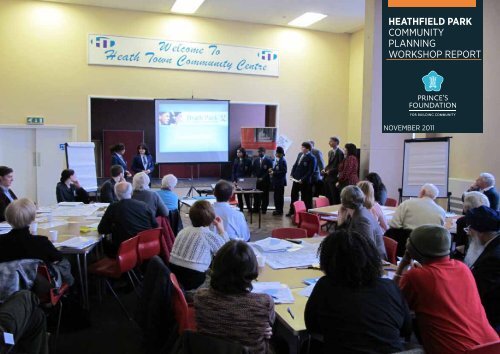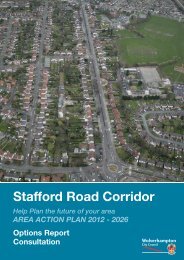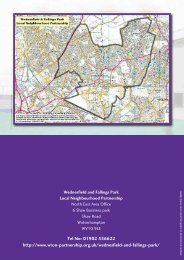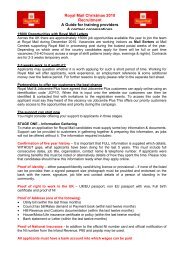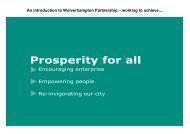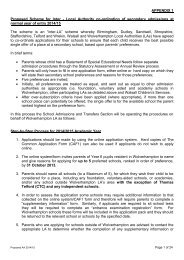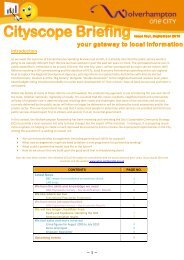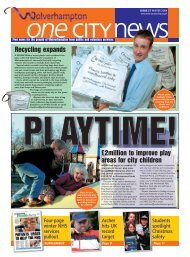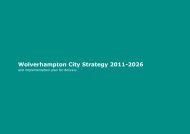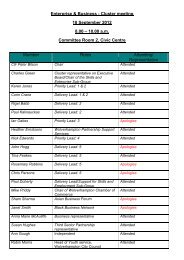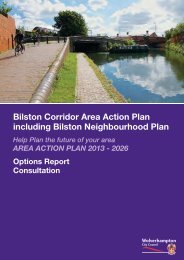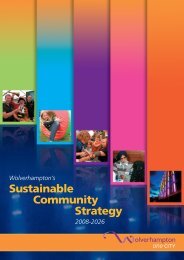HeatHfield PaRK community planning workshop report
HeatHfield PaRK community planning workshop report
HeatHfield PaRK community planning workshop report
- No tags were found...
Create successful ePaper yourself
Turn your PDF publications into a flip-book with our unique Google optimized e-Paper software.
Heathfield PARKCOMMUNITY<strong>planning</strong>WORKSHOP REPOrtnovember 2011HEATHFIELD PARK <strong>community</strong> <strong>planning</strong> <strong>workshop</strong> <strong>report</strong> 1
Holy Trinity Church
CONTENTS CONT.SECTION 2 MAPPING OUT ISSUES FOR A NEIGHBOURHOOD PLAN 212.1 session one: identification of key issues 212.2 core themes of a neighbourhood plan 232.3 session two: visioning exercise 23IN PARTNERSHIP WITHSECTION 3 conclusions and rECOMMENDATIONS 26Appendices 28 - 31Appendix AAppendix BAPPENDIX Cappendix d<strong>workshop</strong> participantsWORKSHOP PROGRAMMEWORKSHOp drawingWORKSHOp drawingTHE PRINCE’S FOUNDATIONfor BUILDING COMMUNITY:TRANSFORMING LIVES through ENGAGINGEDUCATING and EMPOWERING people19—22 Charlotte RoadLondon EC2A 3SGUnited KingdomE enquiry@princes-foundation.orgT +44 (0) 20 7613 8500F +44 (0) 20 7613 8599www.princes-foundation.orgPresident: HRH The Prince of WalesA Company Limited by guarantee No. 3579567Registered Charity No. 1069969VAT No. 839 8984 442 PRINCE’S FOUNDATION PROJECT REPORTNOTE: THIS REPORT HAS BEEN FORMATTED FOR DIGITAL RELEASE ONLY
students of heath park schoolpresent their viewsMIDDLEPORTPOTTERYHEATHFIELD PARK <strong>community</strong> <strong>planning</strong> <strong>workshop</strong> <strong>report</strong> 3
Participants discussingtHE pRINCE’S fOUNDATION4 PRINCE’S FOUNDATION PROJECT REPORT
IntroductionHeathfield Park is a residential area located on the eastern edgeof the city centre identified by the City Council as forming theproposed neighbourhood Plan area. It covers 174 hectares andincludes three distinct neighbourhoods - Springfield, New ParkVillage, and Heath Town estate.The Heathfield Park Local Neighbourhood Partnership (LNP) arearoughly covers the same area as the Neighbourhood Plan, extendingfrom the eastern edge of the City Centre to the western edge of theBentley Bridge Retail Park. It is bounded by the A460 Cannock Road tothe north and the Wyrley and Essington Canal to the south east, with anumber of railway lines in the area.Within Heathfield Park, the Heath Town Estate is characterised byseveral high rise blocks (situated on Wednesfield Road), maisonettesand houses, the majority of which are in Council ownership. Thereare traditional terraces of houses in Springfield, whereas New ParkVillage includes low rise estate housing and maisonettes. A few smallindustrial estates are found throughout and adjacent to the area. Somelarge industrial sites including, for example, the Chubb Works andBentley Bridge have been converted into residential and/or mixed usedevelopments. Heathfield Park is also home to New Cross Hospital, themain hospital serving Wolverhampton.Heathfield Park has seen significant change to its economy, socialcircumstances and environmental conditions. Its future development– much like its past – will be mediated by wider changes to the Cityof Wolverhampton and the Black Country. As local communities areinfluenced by development at the metropolitan level, the West Midlandsfuture will be shaped by the recovery and ‘rebalancing’ of the UKeconomy. Building local communities’ capacity to respond to suchchange – both within their neighbourhoods and beyond – iscentral to the reform of UK <strong>planning</strong> policy.Planning policy in the UK is in a period of transition. The draftNational Planning Policy Framework (NPPF) has passed throughstatutory consultation and will come into effect in the first quarterof 2012. The core principles of the NPPF are local autonomy and apresumption in favour of sustainable development. Closely linked to thisis a ‘bottom-up’ perspective which places communities at the centre ofa simplified <strong>planning</strong> process. To this end, neighbourhood <strong>planning</strong> isa way for communities to choose where new developments will occur,provide input into what they should look like and participate in thedetermination of <strong>planning</strong> proposals (CLG, 2011).ABOVE; STUDENTS OF WODEN PRIMARYSCHOOL PRESENT THIER VIEWSHEATHFIELD PARK <strong>community</strong> <strong>planning</strong> <strong>workshop</strong> <strong>report</strong> 5
introduction cont.The move to a <strong>community</strong>-led <strong>planning</strong> policyis an opportunity for Heathfield Park LNPand Wolverhampton City Council to worktogether to play a stronger role in the <strong>planning</strong>process.To this end, the Council and Heathfield Park LNP invited the Prince’sFoundation to facilitate a one-day <strong>community</strong> scoping <strong>workshop</strong> inNovember 2011. The purpose of the event was to bring together localresidents, <strong>community</strong> groups, stakeholders and relevant public andprivate organisations to:1 identify and explore the nature of HEATHFIELDPARK’S assets, liabilities and opportunities.2 map out a range of issues and themes that aprospective neighbourhood plan should address.3 identify organisations and individuals who canlead the neighbourhood <strong>planning</strong> process and beginto develop an action plan.The <strong>workshop</strong> sought to address each of these aims against theconstraints of the current economic climate and the uncertaintyinherent to a transition in <strong>planning</strong> policy. Its outcome was theidentification of a number of key themes that can be used as a basisfor the development of a neighbourhood plan. This <strong>report</strong> highlightsthe main findings of the <strong>workshop</strong> and outlines the next steps in thedevelopment of this collaborative process.WORKING METHODS AND MODELSOF THE PRINCE’S FOUNDATIONThe Prince’s Foundation has three coreareas of work – education, empowermentand engagement. The Foundation’s vision of<strong>planning</strong> is based on the understanding thatcommunities have to be engaged and involvedat all stages of the process, from inceptionto delivery. To this end it uses a collaborative<strong>planning</strong> tool which brings together public andprivate organisations with <strong>community</strong> residentsto collectively participate in designing a visionof a neighbourhood or town. This is achievedthrough <strong>workshop</strong>s facilitated by The Prince’sFoundation where technical experts (fromdisciplines such as engineering, transportand architecture) work together with localexperts (such as neighbours and historians)to explore a range of alternative developmentscenarios. This process involves discussing thetrade-offs of a proposal and testing the specificdesign requirements for the development ofa site by actually drawing them. In doing so,participants can learn from each other andvisualise possible solutions.Community CapitalRegardless of scale or location, the conditionsof sustainable development are derivedfrom the assets that can be found in allcommunities. To understand how these assetscan be strengthened and embedded within<strong>planning</strong> policy, The Prince’s Foundation hascreated ‘<strong>community</strong> capital’. This conceptualmodel characterises the different aspectsof a <strong>community</strong>’s assets into four broadtypes - natural, financial, social and built.This includes both the intangible assets ofa <strong>community</strong> such as the quality of its socialnetworks or appeal of its markets and the(more) tangible elements such as the integrityof its transport system, historic buildings andgreen space.ABOVE; PARTICIPANTS IDENTIFYING ISSUES ANDASSETS OF HEATHFIELD PARKRight: participants identifying key themes forthe neighbourhood plan6 PRINCE’S FOUNDATION PROJECT REPORT
HEATHFIELD PARK <strong>community</strong> <strong>planning</strong> <strong>workshop</strong> <strong>report</strong> 7
ABOVE; participants identifyingissueS TO ADDRESS.RIGHT; PARTICIPANTS DISCUSSING8 PRINCE’S FOUNDATION PROJECT REPORT
SECTION 1 scoping <strong>workshop</strong>, 22 November 2011The scoping <strong>workshop</strong> was opened by David Cope, Chair ofHeathfield Park Neighbourhood Planning Sub Group, supported byKim Hitch, project manager of the Prince’s Foundation followed bypresentations from three schools in the area.1.1 Technical PresentationsDavid Cope explained that the Heathfield Park LNP is working withthe Wolverhampton City Council to determine how it can participatein a simplified, bottom-up <strong>planning</strong> process and, more specifically,to develop a neighbourhood plan. It has led a series of consultationsincluding a consultation event (held in August, 2011) where residents,<strong>community</strong> associations and local businesses looked at a range ofissues including housing, recreational facilities, employment andenvironmental assets. It also facilitated “walkabouts” with the localprimary schools to identify issues and areas for improvement. Thisprocess identified a number of aspirations and issues that a local planshould address including the possibility to:work with landlords, specifically those in theprivate rental market, to improve the (existing)housing stockensure that the Decent Homes programme isdeliveredprovide more business support for the localretailersimproved local assets including, for example, theWryley & Essington Canalenhance access to and increase the provision ofemployment and formal training programmes1.2 The Views of Students fromWoden Primary, St StephensPrimary and Heath Park Business& Enterprise CollegeStudents from all schools had undertakenwalking tours of the neighbourhood andidentified specific areas and issues thatrequired improvement. These presentationshighlighted that both students and staffhave a strong sense of pride in the area andidentify with its heritage assets. They believethat the neighbourhood plan should addresscongestion, road safety and the image of thearea, possibly through the establishmentof environmental works and maintenanceprogramme. Broadly the pupils liked theopen spaces and play areas and emphasisedthe importance of green space and (access to)recreational facilities, but they disliked thelitter and dumping, the derelict buildings andgraffiti.1.3 Historic Development ofHeathfield ParkSue Whitehouse, Historic EnvironmentOffice charted the historic development ofHeath Town. Since the 17th century whenit was first settled, a number of milestoneshave characterised the development of theHeathfield Park area. These include theopening of Grand Junction Railway Station in1837, the establishment of Heath Town UrbanDistrict Council in 1896 and the relocationof Wolverhampton Workhouse in 1903. Theworkhouse was subsequently converted intoNew Cross Hospital and in 1931 Heath TownBaths and Library opened. Statutory ListedBuildings in the area include Holy TrinityChurch, Lich Gate (at Holy Trinity Church),Holy Trinity Almshouses and Heath TownBaths and Library.HEATHFIELD PARK <strong>community</strong> <strong>planning</strong> <strong>workshop</strong> <strong>report</strong> 9
ABOVE; HEATHFIELD PARK NEIGHBOURHOODBOUNDARY ENLARGEDRIGHT; HEATHFIELD PARK NEIGHBOURHOODBOUNDARY overview10 PRINCE’S FOUNDATION PROJECT REPORT
1.4 - 7 scoping <strong>workshop</strong>, 22 November 20111.4 Planning contextIan Culley, (Wolverhampton City Council Planning Team) emphasisedthat it is important that the neighbourhood plan is embedded withinthe wider <strong>planning</strong> context and is consistent with the the Black CountryJoint Core Strategy (Adopted in February 2011) and the WolverhamptonUnitary Development Plan (2006). The UDP has been (in part)superseded by the Core Strategy but is (still) used as a basis to determineif <strong>planning</strong> applications are approved or rejected. Together, thesedocuments set the ‘<strong>planning</strong> envelope’ for Heathfield Park. To this end,it has been defined as an area that will provide:a range of good quality residential developments with amix of housing types, sizes and tenuresa network of green infrastructure and <strong>community</strong>facilitiesaccessible (transport) links to the city centre tofacilitate access to employment opportunitiesa rolling stock of small scale development opportunitiesEqually important, under the City Council’s Local Investment Plan(2010), Heath Town estate has been identified as a priority area ofHousing Market Intervention.1.5 ECONOMIC DEVELOPMENTGraham Clark provided an overview of Heathfield Park from a socioeconomic perspective. The area has a population of approximately7,300; its demographic profile is younger and more diverse than thecity average partly due to the presence of three primary schools anda secondary school (Heath Park Business and Enterprise College). Ahigh proportion of school children do not speak English as their firstlanguage.Approximately 58% of its residents are economically active (which isbelow the city average), with 35% working in plant and machine-basedoccupations or elementary jobs, which is 7% below the city average. Assuch Heathfield Park is identified as one of the most deprived areas ofWolverhampton. Average income is low andthe unemployment rate at 11.3 % and benefitdependency are significantly higher than thecity average. More than 40% of the populationhave no formal qualifications.With regards to household profiles, owneroccupation is almost half the city average at33%, with 53% of homes rented from Councilor Housing Association, compared to nearly30% across the city. 28% live in single personhouseholds. 53% of households don’t have acar. There is a defined local centre (HeathTown) as well as the Crossways ShoppingCentre, although the recession has seenthe closure of local business and increasein vacancy rates. Access to employmentopportunities in neighbouring areas ofWolverhampton is limited. Both New CrossHospital and Royal Mail are key employerslocated in/adjacent to the area and yet theirworkforces are drawn from the wider region.As such, there are few opportunities foremployment in the local area.1.6 Wolverhampton City Council’sHousing StrategyThe broad objective of the draft City Council’sHousing Strategy (2011) is to increaseeconomic growth and support the physicalregeneration of the city. To this end, theHousing Strategy proposes to:bring 200 long-term empty propertiesback into use (per annum), specificallyin the spatial priority areasintroduce a Private Sector LeasingScheme and encourage privatelandlords to join the schemeimprove frontages in specific areasand raise housing standards inselected private housing areasthrough the provision of advice tolandlords and the selective licensingof the private rented sectorpromote and expand housing choiceacross Wolverhampton through“Homes in the City”, a city–wide systemfor letting homesPotential housing sites are shown on theneighbourhood plan map on the followingpage.1.7 WOLVERHAMPTON HOMES AND THEDECENT HOMES PROGRAMMEAngie Madden, representative ofWolverhampton Homes, outlined its role asthe agency responsible for managing HeathTown estate on behalf of the Council. Beyondrepairs and maintenance, WolverhamptonHomes is responsible for the delivery of theDecent Homes Programme. To this end, ithas a team of staff based at Chervil Rise anda dedicated Community Partnerships Officerwhose remit focuses on working with tenantsand residents on determine priorities forimprovement. More than 50% of the homesin the neighbourhood plan area are rentedfrom Wolverhampton Homes or a HousingAssociation.HEATHFIELD PARK <strong>community</strong> <strong>planning</strong> <strong>workshop</strong> <strong>report</strong> 11
12 PRINCE’S FOUNDATION PROJECT REPORT
1.8 - 9 scoping <strong>workshop</strong>, 22 November 2011The level of owneroccupation, atapproximately 33%, is lessthan half the city average.More than one-quarter ofresidents (28%) live alone.Wolverhampton Homes is responsible for themanagement of 1,200 properties on the HeathTown estate of which the average length oftenancy is seven years and the average cost ofrepairs and maintenance is £170 per propertyper annum. It has a low level of voids anddemand for accommodation is comparableto other estates in the city. Under the DecentHomes Programme, the estate will see aninvestment of £11.5m in 2014/15 to improvethe housing stock. Priorities identified bythe residents include parking improvements,pigeon and cockroach control, the (increased)provision of <strong>community</strong> facilities and play areasand the creation of a maintenance and worksprogramme to improve the image of the estate.1.8 Open Space and EnvironmenalAssetsHeathfield Park has a mix of environmentalassets - most notably Heath Town Park andthe nearby Fowlers Playing Fields (the districtpark for the wider area), as well as allotmentsand play facilities for children. Access to openspace, parks and recreational facilities hasbeen identified as an issue that needs to beaddressed. Specific sites where accessibilityis limited (or prohibited) include White’sField and Bowmans Harbour (adjacent to thearea). Areas where investment could increaseopportunities for recreation include theopen spaces adjacent to the neighbourhoodplan area such as Fowlers Playing Fields andSpringfield Brewery. Unresolved issues thatcould be addressed by the neighbourhood planinclude the designation of specific uses of openspace, the identification of specific locationswhere the provision of open space is limited(including, for example, adjacent to New CrossHospital) and the allocation of resources tomaintain sites and deliver improvements.1.9 FUTURE DEVELOPMENTHeathfield Park is situated at the junction ofStafford Road, Bilston and WolverhamptonCity Centre. Under the Core Spatial Strategy,these three areas have been defined asRegeneration Corridors. The area thereforeforms an important link between these areas.Recent developments include the constructionof 130 dwellings on the former Chubb Siteand planniong approval for a further 156homes, the majority of which will be built atNew Cross Hospital. Approved developmentsinclude the provision of a new medical centreand the installtion of a new biomass boiler toupgrade the existing district heating schemeon the Heath Town estate. There is proposeddevelopment for 35 dwellings on Grove Street.right: POTENTIAL HOUSING SITESIN HEATHFIELD PARK.overleaf: transport issueshighlighted during the <strong>workshop</strong>HEATHFIELD PARK <strong>community</strong> <strong>planning</strong> <strong>workshop</strong> <strong>report</strong> 13
1.10 - 12 scoping <strong>workshop</strong>, 22 November 20111.10 TRANSPORTWednesfield Road is an essential link betweenWolverhampton, Wednesfield and the widerregion. Carrying more than 23,000 vehiclesper day, it also serves frequent bus servicesto New Cross Hospital. Future (regional)investments will see the opening of a newmetro line or a rapid transit bus service on thisroute.Similarly, Cannock Road is an importantcorridor between Wolverhampton, the widerStaffordshire area and key junctions on theM54 and M6. High volumes of traffic onboth of these links (particularly heavy goodsvehicles) mean that congestion during peakperiods is increasingly problematic At the sametime, the strategic roads that isolate HeathfieldPark from its environs also provide access tothe main areas of employment and possibledevelopment opportunities near SpringfieldBrewery. Equally important concerns are‘pinch points’ in the transport network such asWednesfield Road and Wednesfield Way.Key transport junctions and ‘hot-spots’ on theWednesfield Road Corridor and the StaffordRoad and Cannock Road Corridor are shownon the following pages. An important issuethat the neighbourhood plan has to addressis the relationship between transport andaccessibility. The residents and organisationsof Heathfield Park would benefit frommeasures to support ‘active travel’ such as theprovision of cycle paths, walkways and trafficcalming.above and right: ACTIVITES OF THE HOPECOMMUNIty PROJECT: youth support andRECREATION and the heathfield park lunchclub1.11 Community Focus1.12 The Hope Community ProjectCommunity Focus was introduced by Debbie Humphries as anindependent charity based in the Chervil Rise precinct on the HeathTown Estate.It offers a range of confidential (pro-bono) services including theprovision of advice and information and guidance specifically to helpvulnerable people understand and submit applications and forms inorder to secure state benefits and access housing services etc.It also offers casework assistance to address legal issues (related to,for example, indebtedness and housing) and helps clients to findemployment and to gain access to training courses.Sue Allen presented the work of the Hope Community Project whichalso supports vulnerable people living in Heath Town estate.It does so through a range of outreach activities such as door knocking,telephone-based support, home visits and various thematic events suchas health and well-being days and day trips to destinations such asDrayton Manor and Twin Lakes. Equally important, the charity providesEnglish language tuition and runs a lunch club in partnership withHoly Trinity Church and the Heathfield Park Local NeighbourhoodPartnership.16 PRINCE’S FOUNDATION PROJECT REPORT
HEATHFIELD PARK <strong>community</strong> <strong>planning</strong> <strong>workshop</strong> <strong>report</strong> 17
1.13 - 15 scoping <strong>workshop</strong>, 22 November 20111.13 Holy Trinity ChurchHoly Trinity Church also runs a number of <strong>community</strong> projects, most notably its Community Garden and its Wildflower Meadow initiative as partof its Living Churchyard Project. Part of the project focus is to create better access for people to use the open space as a resource and to encouragewildlife through creating improved habitats. As well as caring for the churchyard this project considers issues around best use of the space whilsthonouring those buried here, <strong>community</strong> maintenance and people and wildlife benefits.The main aim is to encourage people to ‘get involved’ and participate in activities such as youth projects as well adult organisations such as theHope Community Project and Walking for Health. Funding comes from a number of sources: the renovation of the graves in the Almshouses areawere financed by Wolverhampton City Council and the Working Neighbourhoods Fund.The Community Garden was funded by a grant of almost £50,000 from Community Spaces, managed by Groundwork UK on behalf of the BigLottery Fund. The Wildflower Meadow was made possible through a grant of approximately £84,000 from Natural England as part of its Access toNature programme funded from the Big Lottery Fund’s Changing Spaces initiative.1.14 EDUCaTIOnSteve Hammond introduced the HeathPark School. Under the “Building Schoolsfor the Future” (BSF) programme, HeathPark School will be rebuilt through a privatefinance initiative. Construction is scheduledto begin in the third quarter of 2012 and theprovisional opening date is September 2014.The new school will see the developmentof a state of the art building that comprisesoutdoor learning spaces, recreational facilitiesand sports facilities and a new ICT facility. Partof the College’s remit is to provide access forthe <strong>community</strong> to facilities and training.1.15 recreationAmanda Bevan of the Tessa SandersonFoundaton described the Foundation’s planto redevelop Heath Town Baths and Library.To this end it is seeking potential fundersand will hold a formal consultation with the<strong>community</strong>. The Foundation’s vision is tocreate a ‘sports academy’ where residents canparticpate in sport and receive coaching tofulfill their potential and possibly compete atan elite level.1.16 HEALTHWolverhampton has two main healthcareinstitutions within the Heathfield Park area- Wolverhampton City Primary Care Trust(PCT) and the Royal Wolverhampton NHSTrust. Dr Adrian Phillips , Director of PublicHealth, Wolverhampton PCT set out the coreaim of the PCT is the provision of primarycare in the City of Wolverhampton. Healthcare provision has been identified as a priorityin the Heathfield Park area. To this end, aPrivate Finance Initiative has been negotiatedwith PFI Lift Company to build a newhealth facility in Heathfield Park. Planningpermission has been granted for this healthcentre to be built on the Duke of York siteon the Wednesfield Road. The PCT are nowawaiting approval from the Strategic HealthAuthority which should be granted by early2012.David Loughton, Chief Executive, RoyalWolverhampton NHS Trust set out the positionof New Cross Hospital within the area andexplained the challenge of being a ‘goodneighbour’ to local people living in an areaserved by the Hospital. In April 2011, theRoyal Wolverhampton NHS Trust increasedits capacity through a merger with the PCT’s<strong>community</strong> services. An initial proposal toprovide a home-based <strong>community</strong> healthcare services - thereby avoiding the pressureassociated with hospital visits - is no longerviable following the withdrawal of funding.David Loughton highlighted that a long-termsolution is required to address car parking inthe vicinity limited of New Cross Hospital andreduce its impact on local residents.18 PRINCE’S FOUNDATION PROJECT REPORT
LEFT; THE GRAVESTONES AT HOLYTRINITY CHURCHABOVE; heath park schoolidentify issuesHEATHFIELD PARK <strong>community</strong> <strong>planning</strong> <strong>workshop</strong> <strong>report</strong> 19
above; heath park school present thefindings of their ‘walkabout’RIGHT; participants begin to map outopportunities for a prospectiveneighbourhood plan20 PRINCE’S FOUNDATION PROJECT REPORT
SECTION 2 Mapping out issues for a neigbourhood planFollowing thepresentations, theparticipants broke intothree groups to mapout common issues andaspirations in the contextof two scenario buildingexercises.All stakeholders were asked to discuss their views and perceptions onthe future of Heathfield Park. This involved identifying general trendsand changes in the area and highlighting issues that could be addressedin the short-term as well as possible opportunities for long-terminvestment. This process helped to start to generate broad consensusaround issues and prioritise those issues which could be addressed bythe neighbourhood plan.2.1 SESSION one: IDENTIFICATION OF KEY ISSUESEach stakeholder was asked to identify key issues that needed tobe addressed. To this end, all participants were aksed to envisagethree possible changes to the area and given several post-it notes tocollectively prioritise five issues justifying what needed to change andwhy.ISSUES AND ASPIRATIONSGROUP 1 GROUP 2 GROUP 3Improved publictransport linksPositive identity andimproved public realmImproved access togreen space and to jobsReduced unemploymentIncreased provision ofrecreation facilities andopportunities for ‘activelifestyles’Increased provision ofaffordable housingWider involvement fromthe <strong>community</strong>Improved visual qualityof the neighbourhoodChange perceptions ofthe area and generate asense of prideIncreased support forstart-up businessesand locally-basedemploymentAccess to and flexibleuse of existing<strong>community</strong> facilitiesBuilding Schools for theFuture programme tostimulate links betweeneducation, employmentand trainingImproved managementof the area, specificallyHealth Town estateIncrease the frequencyof <strong>community</strong>-led eventsIncreased use of existing<strong>community</strong> facilities/assetsFewer derelictproperities andunderused facilitiesIncreased provision ofsocial care for the elderlypopulationExplore opportunitiesfor self-build projectssIncrease the provisionof recreation facilities,specifically for youngpeopleCreate an identifiableheart within the<strong>community</strong>Improve the image ofthe areaHEATHFIELD PARK <strong>community</strong> <strong>planning</strong> <strong>workshop</strong> <strong>report</strong> 21
PARTICIPANTS IN ACTIONNEED FULL PAGE IMAGE— ANOTHERPRESENTATION PHOTO?22 PRINCE’S FOUNDATION PROJECT REPORT
2.2 - 3 Mapping out issues for a neigbourhood plan2.2 core themes for aneighbourhood planThrough the process of exploring a rangeof <strong>community</strong> aspirations, the <strong>workshop</strong>participants began to identify a number ofcore themes for a prospective neighbourhoodplan:Employment and TrainingTransport and AccessibilityHousing and Community AssetsHeathly LifestylesIdentity and Public Realm2.3 session two: visioning exerciseFor session two, each of the three groups was asked to consider options for change andexplore specific proposals to tackle the identified issues and core theme.Group 1The role of communication was identified as an important area specifically to change andchallenge (existing) perceptions of the area; generate a sense of pride and improve HeathfieldPark’s image and identity; expand residents’ access to existing social networks and <strong>community</strong>events specifically those led by active churches and charities working in the area and use socialmedia (twitter, facebook) alongside conventional methods (newsletters, public notice boards)to raise awareness of <strong>community</strong>-led activities and public meetings. Other areas that the groupaddressed included:Public realm Enhance access to(underused) public space and findingways to manage and maintain the publicrealm including improving services.Employment Support existingbusinesses to expand (where this isviable) and identify opportunities tosupport the creation of new jobs andbusinesses. The group also recongisedthe importance of access to professionaldevelopment courses and skills trainingand the possibility to develop links toHeath Park Business and EnterpriseCollege.Education and RecreationStrengthen links between schools andcommunities and explore the possibilityto extend the normal operating hours sothat local (young) people have access torecreation facilities.Health Improve the provision of socialcare for elderly residents and address theneed for health care centres.Housing Increase the provision ofaffordable housing and provide claritywith regard to the redevelopment ofHeath Town estate.Transport and AccessibilityDevelop a traffic management strategy,specifically to address the parking ‘spillover’from New Cross Hospital and theabsence of pedestrian crossings and linksfrom Heathfield Park to WolverhamptonCity Centre.above; THEMES AND PROPOSALS IDENTIFIED BY GROUP 3.HEATHFIELD PARK <strong>community</strong> <strong>planning</strong> <strong>workshop</strong> <strong>report</strong> 23
<strong>workshop</strong> drawing,group three24 PRINCE’S FOUNDATION PROJECT REPORT
2.3 cont. Mapping out issues for a neigbourhood planGroup 2The main issues identified by Group 2 includedpoverty and associated social issues, the lackof employment opportunities, the negativeperceptions of Heathfied Park and the absenceof a <strong>community</strong> ‘hub’ or ‘anchor’. High volumesof traffic and parking management was flaggedup as an issue that required immediate actionnot least to address unsafe crossing points,rat-running and the physical isolation of the<strong>community</strong> due to arterial routes.The group identified <strong>community</strong> cohesion asa positive aspect of the area which should beenhanced, especially the strength of the localchurch congregations and other local groups.Possible actions or projects to address suchissues included a Heathfield Park carnival,specifically to celebrate the diversity of the areaand bring residents together.Suggestions to improve the quality of thepublic realm and change the image of thearea included tree-planting, new signage anda <strong>community</strong> management group. The needfor a ‘<strong>community</strong> hub’ where all residentscould receive support and advice related toemployment, training, parenting and life skillswas identified by a number of participants.Group 2 also expressed concern as to theirexpertise and knowledge to be able to lead sucha process and put together a neighbourhoodplan. Some felt daunted by the task and feltthat they would need assistance. To this end,an action plan was proposed, specificallyto identify leaders in the <strong>community</strong> and todetermine what skills, resources and assistancewould be required to create change.Group 3Group 3 identified six key issues: employment,healthy lifestyles, affordable housing,green spaces, neighbourhood identity andconnectivity and transport. To address theseissues, a number of proposals were madeunder the following three themes.Theme 1Create a thriving <strong>community</strong> witha heart’Identify a new <strong>community</strong> meetingfacility-with facilities for all agesand activitiesCreate new walkable pedestriancycle routes linking a new healthcentre, <strong>community</strong> centre, shopsand facilities; leisure hub and a newinnovation parkCreate appropriate housing mixincluding family housing by removingwalk way bridges on Heath TownEstate, reconfiguring the maisonetteblocks on Heath Town Estate tovertical houses. Aspirations toincrease the provision of privategarden space and strike a balancebetween the provision of carparking and shared space were alsohighlightedTheme 2Access to Employment andTrainingCreate an innovation centre (focusingon light industry) on existing vacantland which would have links to theUniversity and New Cross Hospital.Increase access to and the provisionof training to improve the skill setof the local <strong>community</strong> and enablethem to contribute to University andHospital research initiativesOutreach and training programmesfocusing on IT skills, an adulteducation centre and Englishlanguage coursesTheme 3:Healthy Living ProgrammeSelf-build project as affordablehousing or <strong>community</strong> land trustCreation of an exercise circuit oroutdoor gym in one of the openspacesActivities to encourage cycling andwalking and linking these to thedevelopment of green corridorsIntegration of Tessa SandersonSports Academy and <strong>community</strong>‘health care coaches’Food diversity events or festivals topromote healthy eating and promotethe diverse identities represented inthe neighbourhoodabove; <strong>workshop</strong> drawing BY GROUP 3.HEATHFIELD PARK <strong>community</strong> <strong>planning</strong> <strong>workshop</strong> <strong>report</strong> 25
SECTION 3 CONCLUSION AND RECOMMENDATIONSThis <strong>report</strong> highlights the findings of a collaborative<strong>workshop</strong> where <strong>community</strong> residents, stakeholders andstaff of Wolverhampton City Council had the opportunity toidentify, discuss and define their aspirations for the future ofHeathfield Park.The main purpose the <strong>workshop</strong> was to identify the issues and themes that a prospective Neighbourhood Plan could address and determinewhere opportunities for (re)development might emerge. This process enabled the local <strong>community</strong> to understand the scope of their role in the<strong>planning</strong> process and explore where and how they can work with Wolverhampton City Council to turn ideas into practical action. Beyond themotivation to develop a clear plan, the <strong>community</strong> felt that there was a need to show how the delivery of projects can help to regenerate the area.To this end, the following recommendations are intended to accelerate the <strong>planning</strong> process and enable the <strong>community</strong> and its representativesto build on the outcomes of the scoping <strong>workshop</strong>.1 create a steering groupA steering group comprised of leaders inthe <strong>community</strong> (including those from localgroups/organisations and representativesfrom New Cross Hospital and the educationalinstitutions) should be created in order towork with the Council to further develop theissues and themes that are identified in this<strong>report</strong>. Active non-profit organisations whichare working in the area should be included inthis process specifically to engage their (in)formal networks. A co-ordinated and inclusiveapproach would beneficial to the <strong>planning</strong> anddelivery of the neighbourhood plan process.2 Develop an Action Planand Consider the Need forTechnical AssistanceDevelop an action plan which sets out specificmilestones in its inception and delivery. Thisprocess should be led by the Steering Groupand the action plan should identify who isresponsible for delivering what and when. Itshould also include a consultation and <strong>community</strong>engagement strategy. To this end, thepossible need for consultancy support – to helpadvance the Action Plan - should be consideredby the Council and the Steering Group.3 Build on the Key ThemesThe participants identified five key themes:Employment and Training, Transport andAccessibility, Housing and Community Assets,Healthy Lifestyles, Identity and Public Realm.These themes should be further developed, aprocess which should involve the wider <strong>community</strong>and Council and provide a basis for aprovisional Neighbourhood Plan.26 PRINCE’S FOUNDATION PROJECT REPORT
IAN CULLEY (WOLVERHAMPTON CITYCOUNCIL) OUTLINES THE PLANNINGCONTEXTHEATHFIELD PARK <strong>community</strong> <strong>planning</strong> <strong>workshop</strong> <strong>report</strong> 27
appendiX A Workshop ParticipantsJaswinder Chaggar, ResidentDavid Cope, ResidentPat Lockyer, ResidentAMANDA BEVAN, TESSA SANDERSONFOUNDATIONrOSIE fRASER, tessa sandersonfoundationAnna Dowd, Wolverhampton CityCouncilWendy Mills, Wolverhampton CityCouncilNote 49 people attended the<strong>workshop</strong>. Everyone played a partin the development of the ideas andproposals put forward in this <strong>report</strong>.Clyde Taylor, ResidentDANIEL WILLIAMS, RESIDENTjoHN LEE, RESIDENTMARICE SIMMONS, RESIDENTWayne Downing, St StephensAndy Darnley, Heath Park SchoolRebecca Webb, Heath Park SchoolSue Crook, Heath Park SchoolJo Edwards, Woden PrimarySteve Hammond, Heath Park CollegeAmanda Smith, English HeritageKerrith Brown, heath town baths saMargaret Nicholls, Re-EntryBill Nicholls, Re-EntryNicolas Crombie, Heantun HousingA Phillips, Wolves Primary Care TrustDavid Loughton, RWHTEvelyn Brown, Wolverhampton HomesGloria Blair Riley, WolverhamptonHomesAngie Madden, Wolverhampton Homesian Culley, Wolverhampton CityCouncilGraham ClarkWolverhampton City CouncilCllr Margaret FindlayWolverhampton City CouncilSangita KularWolverhampton City CouncilSue Lindup, North East LNP TeamAdam Harper, North East LNP TeamKim Hitch, Prince’s FoundationBettina Bungay-Balwah, Prince’sFoundationNoel Isherwood, Prince’s FoundationRory Moody, Prince’s FoundationThe Prince’s Foundation wouldlike to thank heathfield parklocal neighbourhood partnershipWolverhampton City Council fortheir efforts in bringing the wider<strong>community</strong> together as well ashosting the event in Heath Town’sCommunity Centre.John Goldring, Holy Trinity ChurchYardMarianne Page, Wolverhampton CityCouncilKath Hawtin, Holy Trinity ChurchTessa Meek, Wolverhampton CityCouncilSue Allen, HopeDebbie Humphries, Community FocusCraig Rowbottom,Wolverhampton City CouncilDave Hawtin, NHU KINSue Whitehouse, Wolverhampton CityCouncilJ Pembelton, SHLCas Simpson, Youth ServiceMichelle Ross, Wolverhampton CityCouncili PRINCE’S FOUNDATION PROJECT REPORT
appendiX b <strong>workshop</strong> programmeHEATHFIELD PARK NEIGHBOURHOOD PLANSTAKEHOLDER WORKSHOPTuesday 22 NOVEMBER 20119 am – 4.30 pmHEATH TOWN COMMUNITY CENTRE, CHERVIL RISE, HEATH TOWN,WOLVERHAMPTON9 am ‐ Arrival and Refreshments9.30 am ‐ WelcomeDavid Cope, Chair of Heathfield Park LNP, Neighbourhood PlanningSub Group11.45 pm ‐ Stakeholder Presentations Part 2Economic DevelopmentTransport and HighwaysCommunity FocusHope Family CentreHoly Trinity ChurchTessa Sanderson Foundation12.45 pm ‐ Q/A session with stakeholders1 pm ‐ Building Schools for the Future, Heath Park School1.15 pm ‐ Lunch and Networking2.15 pm ‐ Princes Foundation Facilitated Group Discussions4.15 pm ‐ Wrap up and confirm next steps and actions4.30 pm ‐ CLOSE9.35am ‐ Overview of the Day – Kim Hitch, Princes Foundation9.45 am ‐ Photographic Presentations of Neighbourhood Planning AreaLed by David Cope – Chair of Neighbourhood Planning Sub Groupand Local Schools in the Heathfield Park area10.15 am ‐ Stakeholder Presentations Part 1Local History/Context and CharacterPlanning Context/Core StrategyLandscape and Open SpaceHousing IssuesPCT DevelopmentsNew Cross Hospital11.15 am ‐ Q/A session with stakeholders11.30 ‐ Refreshment BreakHEATHFIELD PARK <strong>community</strong> <strong>planning</strong> <strong>workshop</strong> <strong>report</strong> ii
appendiX C <strong>workshop</strong> drawingiii PRINCE’S FOUNDATION PROJECT REPORT
appendiX C <strong>workshop</strong> drawingHEATHFIELD PARK <strong>community</strong> <strong>planning</strong> <strong>workshop</strong> <strong>report</strong> iv
NOTESv PRINCE’S FOUNDATION PROJECT REPORT
THE PRINCE’S FOUNDATIONfor BUILDING COMMUNITY:TRANSFORMING LIVES through ENGAGINGEDUCATING and EMPOWERING peopleRegistered Charity No. 1069969supporting usIf you want to support us, it’s easy to get involved.Just visit our website atwww.princes-foundation.org/support-usemail us at enquiry@princes-foundation.orgor call us on 020 7613 8584Keeping up to dateIf you want regular updates, sign up for ournewsletter via our website, follow uson Twitter at @princesfound or join uson Facebook at The-Princes-FoundationHEATHFIELD PARK <strong>community</strong> <strong>planning</strong> <strong>workshop</strong> <strong>report</strong> vi


